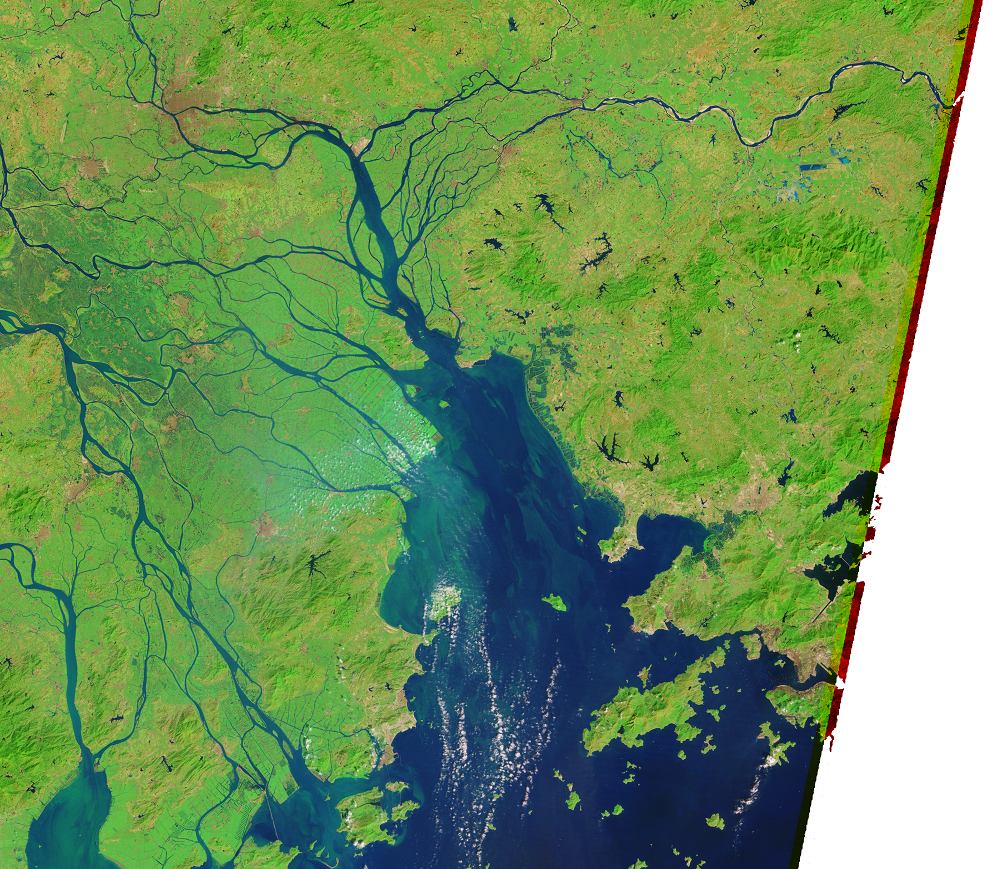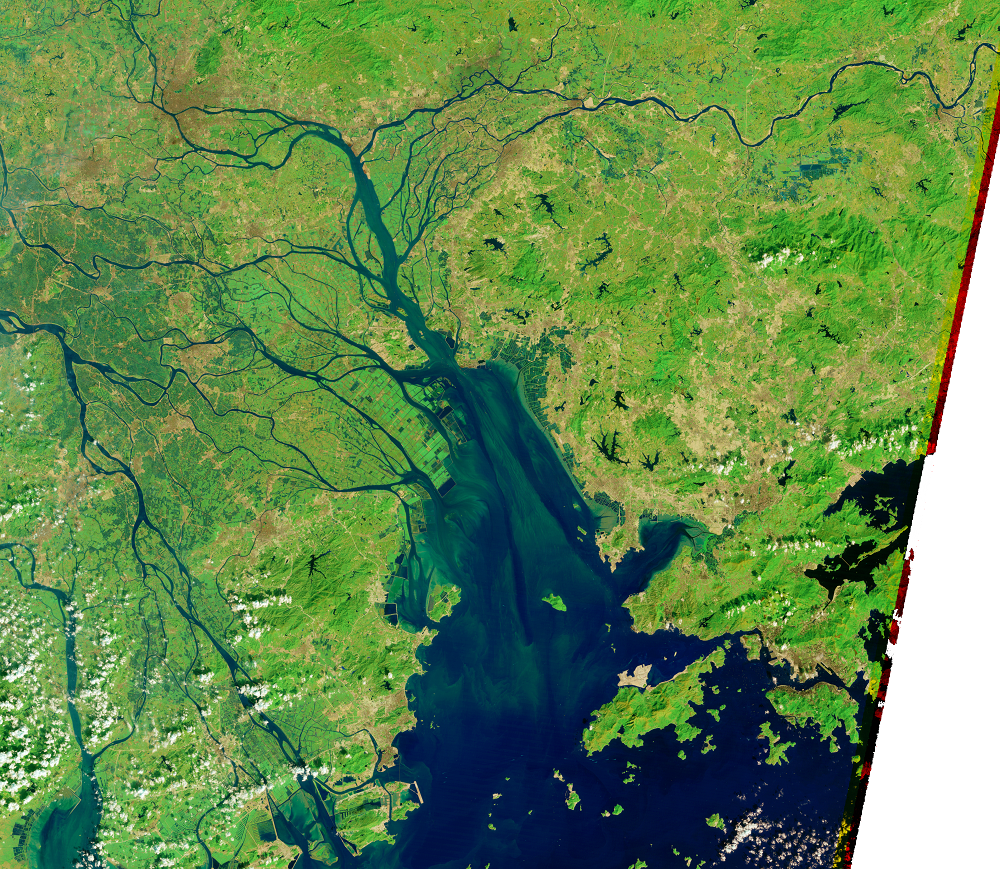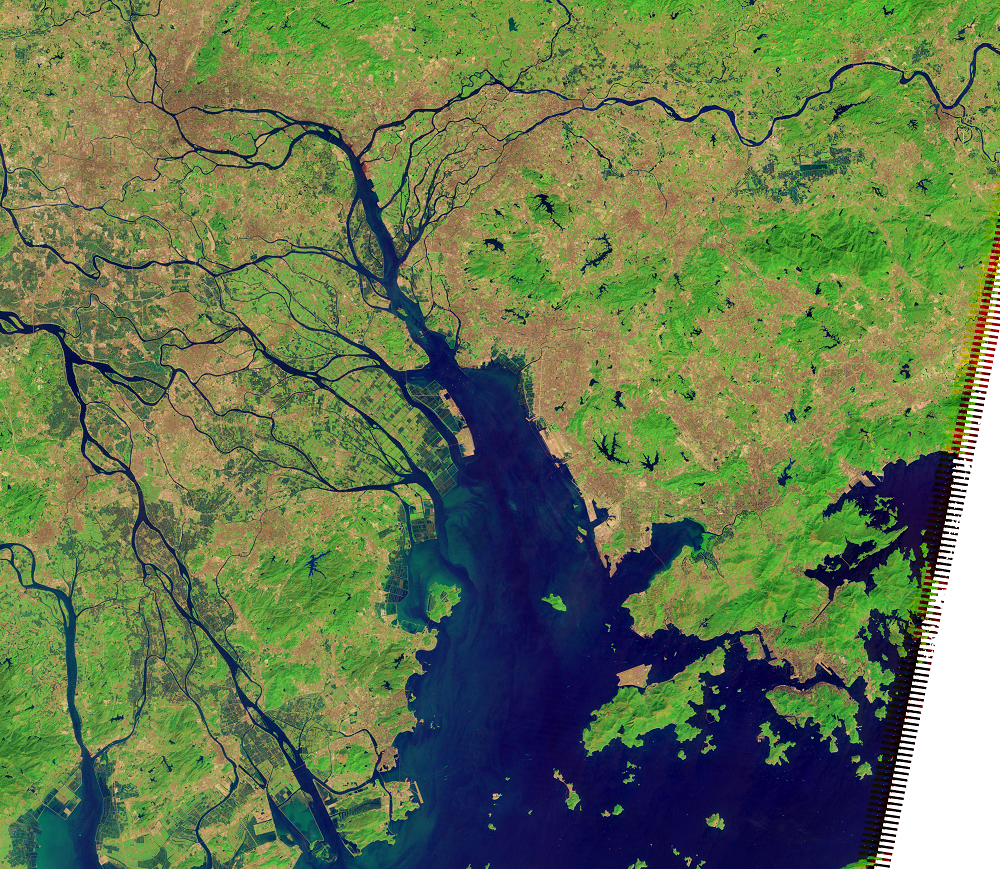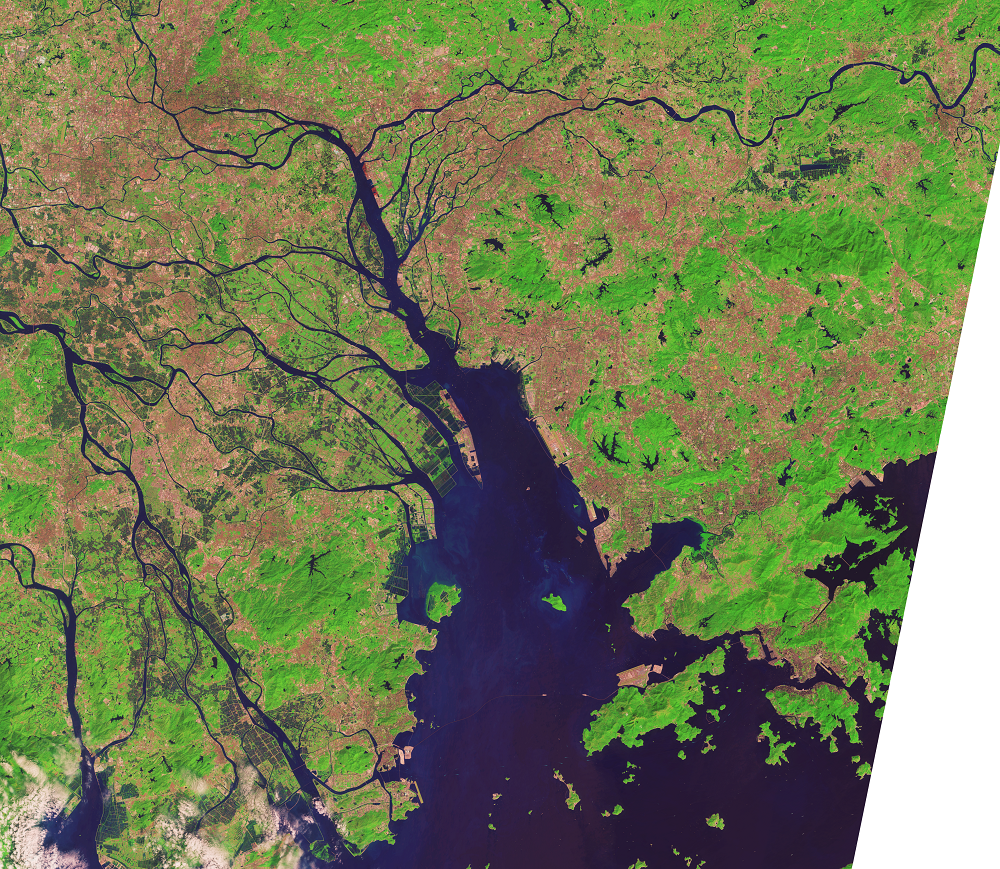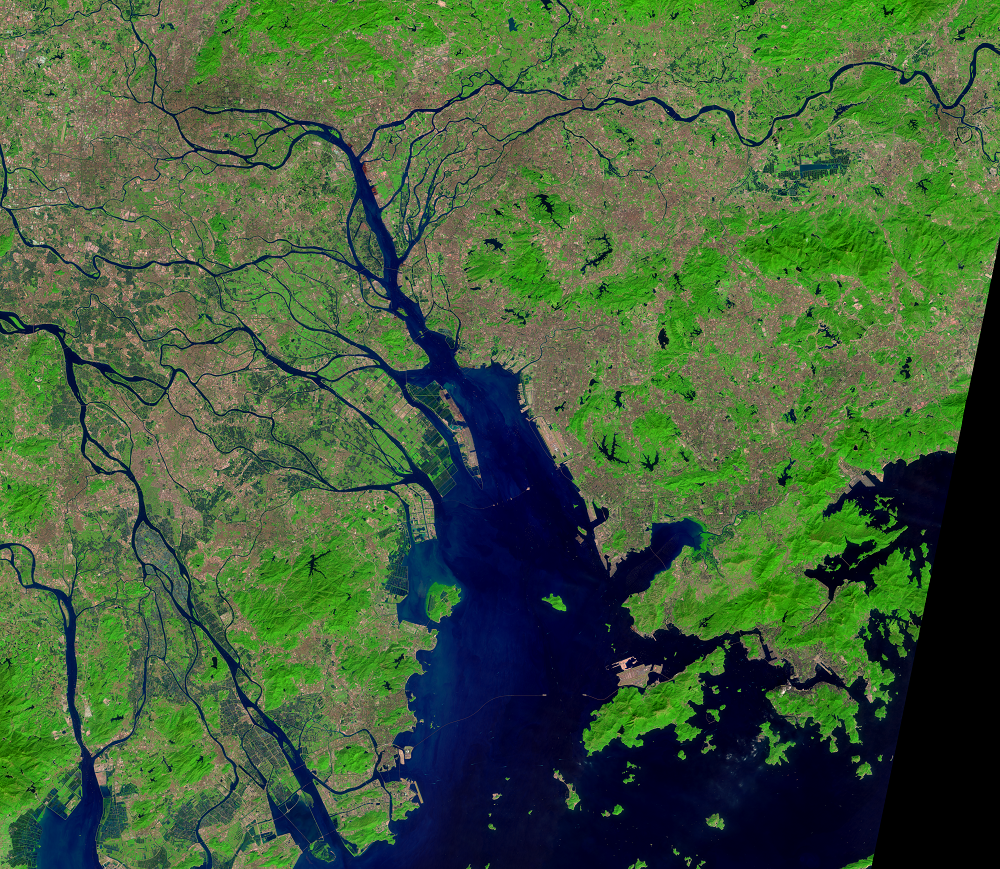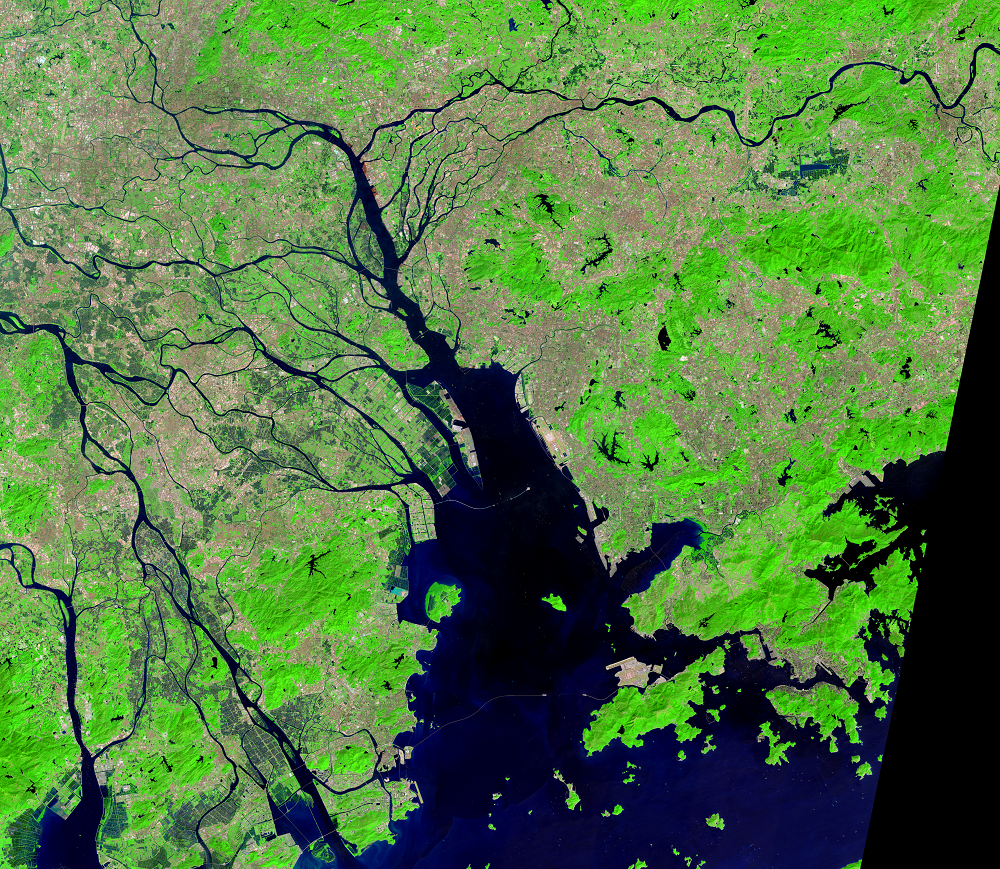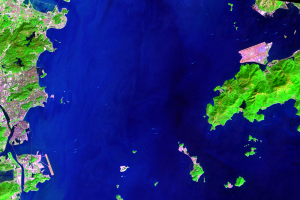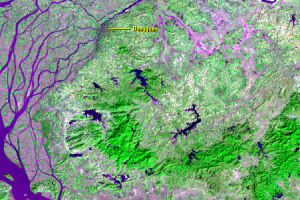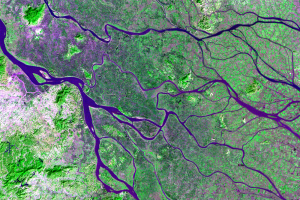In 1978, the Pearl River Delta (PRD) region in southern China had a population of just under 10 million. The population was scattered between several medium-sized cities on an interlacing network of rivers and streams.
Some of those cites have become megacities, and the entire region has merged into one continuous, if scattered, megalopolis with a combined population greater than the six U.S. New England states plus New York, New Jersey, and Pennsylvania.
The PRD now has a population higher than Tokyo, making it the world’s largest urban area.
In 1978, China began new economic policies that loosened regulation for migrating within the country, and people either moved permanently to cities to find work in industry or moved there temporarily for seasonal work. In-migration has been the largest contributor to the rapid population rise. The new model also opened up the country to foreign investment and less government control on private businesses.
Landsat’s long record and spatial resolution make it ideal for mapping change in areas that are urbanizing rapidly, such as the Pearl River Delta. Urban area growth dominates the later images in this Landsat time series.
Municipalities and Special Administrative Regions of the Pearl River Delta
2022 estimated population
| Shenzhen | 17,619,000 |
| Dongguan | 10,646,000 |
| Zhongshan | 4,072,000 |
| Jiangmen | 1,583,000 |
| Huizhou | 1,874,000 |
| Zhuhai | 2,290,000 |
| Guangzhou and Foshan | 26,940,000 |
| Zhaoqing | 791,000 |
| Hong Kong | 7,450,000 |
| Macau | 717,000 |
| Total for the PRD cities | 73,982,000* |
* For comparison, the population of Tokyo is 37,732,000
Imagery
Every picture has a story to tell
Correlated
Additional story information
Downloads
Bie, J., de Jong, M., and Derudder, B., 2015, Greater Pearl River Delta—Historical Evolution towards a Global City-Region: Journal of Urban Technology, v. 22, no. 2, p. 103–123, https://doi.org/10.1080/10630732.2014.971575.
Carlowicz, M., 2016, Bridging the Pearl River Delta: NASA Earth Observatory, accessed June 20, 2018, at https://earthobservatory.nasa.gov/IOTD/view.php?id=88033.
Cooper, M., 2014, China’s Pearl River Delta—Tying 11 Cities into a Megaregion: Urban Land, accessed June 20, 2018, at https://urbanland.uli.org/industry-sectors/infrastructure-transit/chinas-pearl-river-delta/.
Demographia, 2022, Demographia World Urban Areas--Built-Up Urban Areas or World Agglomerations (18th ed.): 93 p., accessed November 1, 2022, at http://demographia.com/db-worldua.pdf.
Du, S., Shi, P., and Van Rompaey, A., 2014, The Relationship between Urban Sprawl and Farmland Displacement in the Pearl River Delta, China: Land, v. 3, no. 1, p. 34–51, https://doi.org/10.3390/land3010034.
Fuller, E., 2017, China's Crown Jewel—The Pearl River Delta: Forbes, accessed June 20, 2018, at https://www.forbes.com/sites/edfuller/2017/10/02/chinas-crown-jewel-the-pearl-river-delta/#2d2941315047.
Lazarus, S., 2018, The $20 billion 'umbilical cord'—China unveils the world's longest sea-crossing bridge: CNN, accessed June 20, 2018, at https://www.cnn.com/2018/05/04/asia/hong-kong-zhuhai-macau-bridge/index.html.
Li Y., Liu K., Liu Y., and Zhu Y., 2017, The Dynamic of Dike-Pond System in the Pearl River Delta During 1964–2012, in Pirasteh S., Li J., eds., Global Changes and Natural Disaster Management—Geo-information Technologies: Cham, Switzerland, Springer, p. 47–59, https://doi.org/10.1007/978-3-319-51844-2_4.
Liu, Z., Huang, H., Werners, S.E., and Yan, D., 2016, Construction area expansion in relation to economic-demographic development and land resource in the Pearl River Delta of China: Journal of Geographical Sciences, v. 26, no. 2, p. 188–202, accessed June 20, 2018, at http://www.geogsci.com/article/2016/1009-637X/38479.
NASA, 2007, Urbanization of the Pearl River Delta: NASA Earth Observatory, accessed June 20, 2018, at https://earthobservatory.nasa.gov/IOTD/view.php?id=7949.
Port of Nansha, [n.d.], Welcome to Port of Nansha: Port of Nansha, accessed June 20, 2018, at http://portofnansha.com/.
Preen, M., 2018, The Pearl River Delta Greater Bay Area Integration Plan: China Briefing, accessed June 20, 2018, at http://www.china-briefing.com/news/2018/02/05/the-pearl-river-delta-greater-bay-area-integration-plan.html.
Roberts, B., Atkins, P., and Simmons, I., 2014, People, Land and Time—An Historical Introduction to the Relations Between Landscape, Culture and Environment: London, Routledge, 304 p.
Seto, K.C., 2005, Economies, Societies, and Landscapes in Transition—Examples from the Pearl River Delta, China, and the Red River Delta, Vietnam, in Entwisle, B., and Stern, P.C., eds., Population, Land Use, and Environment—Research Directions: Washington, DC, The National Academies Press, p. 193–216.
Su, Y., Chen, X., Wang, C., Zhang, H., Liao, J., and Ye, Y., 2015, A new method for extracting built-up urban areas using DMSP-OLS nighttime stable lights—a case study in the Pearl River Delta, southern China, GIScience & Remote Sensing, v. 52, no. 2, p. 218–238, https://doi.org/10.1080/15481603.2015.1007778.
U.S. Census Bureau, 2017, QuickFacts—United States—Population Estimates, July 1, 2017: U.S. Census Bureau, accessed June 20, 2018, at https://www.census.gov/quickfacts/fact/map/US/PST045217.
Voiland, A., 2015, The World’s Largest Urban Area: NASA Earth Observatory, accessed June 20, 2018, at https://earthobservatory.nasa.gov/IOTD/view.php?id=86603.
Voiland, A., 2018, Air Pollution Shrouds the Pearl River Delta: NASA Earth Observatory, accessed June 20, 2018, at https://earthobservatory.nasa.gov/IOTD/view.php?id=91614.
Wong, M.-H., 2017, Chemical pollution and seafood safety, with a focus on mercury—The case of Pearl River Delta, South China: Environmental Technology & Innovation, v. 7, p. 63–76, https://doi.org/10.1016/j.eti.2016.12.004.
World Bank Group, 2015, East Asia's Changing Urban Landscape—Measuring a Decade of Spatial Growth: Washington, DC, The World Bank, accessed June 20, 2018, at http://www.worldbank.org/en/topic/urbandevelopment/publication/east-asias-changing-urban-landscape-measuring-a-decade-of-spatial-growth.
Zhang, L., and Weng, Q., 2016, Annual dynamics of impervious surface in the Pearl River Delta, China, from 1988 to 2013, using time series Landsat imagery: ISPRS Journal of Photogrammetry and Remote Sensing, v. 113, p. 86–96, https://doi.org/10.1016/j.isprsjprs.2016.01.003.
Zhang, L., Weng, Q., and Shao, Z., 2017, An evaluation of monthly impervious surface dynamics by fusing Landsat and MODIS time series in the Pearl River Delta, China, from 2000 to 2015: Remote Sensing of Environment, v. 201, p. 99–114, https://doi.org/10.1016/j.rse.2017.08.036.
Zhao, S., Yi, Z., Wanqi, B., Jiehua, L., Wenhu, Q., Guiping, L., Taolin, Z., Mingzhou, Q., and Leiwen, J., 2001, Population, Consumption, and Land Use in the Pearl River Delta, Guangdong Province, in Growing Populations, Changing Landscapes—Studies from India, China, and the United States: Washington, DC, National Academy Press, p. 207–230.



